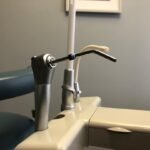Artificial Intelligence (AI) has emerged as a transformative force across various sectors, and dentistry is no exception. The integration of AI technologies into dental practices is revolutionizing how dental professionals diagnose, treat, and manage patient care. From enhancing diagnostic accuracy to streamlining administrative tasks, AI is reshaping the landscape of oral healthcare.
The advent of machine learning algorithms, natural language processing, and advanced imaging techniques has opened new avenues for improving patient outcomes and operational efficiency in dental settings. The application of AI in dentistry is not merely a trend; it represents a paradigm shift that leverages data-driven insights to enhance clinical decision-making. By analyzing vast amounts of data, AI systems can identify patterns and trends that may not be immediately apparent to human practitioners.
This capability allows for more informed decisions regarding treatment options and patient management strategies. As dental professionals increasingly adopt these technologies, the potential for improved patient care and practice efficiency becomes more pronounced.
Key Takeaways
- AI in dentistry is revolutionizing the way dental practices operate, from improving patient experience to enhancing diagnostic accuracy.
- AI applications in dentistry have the potential to significantly improve clinical outcomes and treatment planning, leading to more personalized care for patients.
- AI can enhance diagnostic accuracy in dentistry by analyzing imaging data and identifying patterns that may not be visible to the human eye.
- The impact of AI on treatment planning and personalized care is significant, as it allows for more tailored and effective treatment plans for individual patients.
- AI contributes to streamlining administrative tasks in dental practices, freeing up time for dental professionals to focus on patient care and treatment.
The Role of AI in Improving Patient Experience
AI plays a pivotal role in enhancing the overall patient experience within dental practices. One of the most significant ways it achieves this is through personalized communication. AI-driven chatbots and virtual assistants can provide patients with immediate responses to their inquiries, schedule appointments, and send reminders for upcoming visits.
This level of accessibility not only reduces the burden on administrative staff but also empowers patients by giving them control over their dental care journey. Moreover, AI can facilitate a more engaging and informative experience during dental visits. For instance, augmented reality (AR) applications powered by AI can help patients visualize treatment plans and understand procedures better.
By providing interactive simulations of dental treatments, patients can gain a clearer understanding of what to expect, which can alleviate anxiety and foster trust in their dental providers. This enhanced communication fosters a collaborative relationship between patients and practitioners, ultimately leading to higher satisfaction rates.
AI Applications for Clinical Outcomes in Dentistry
The clinical applications of AI in dentistry are vast and varied, significantly impacting patient outcomes. One notable application is in the realm of predictive analytics, where AI algorithms analyze patient data to forecast potential health issues. For example, machine learning models can assess a patient’s history, lifestyle factors, and genetic predispositions to predict the likelihood of developing conditions such as periodontal disease or dental caries.
This proactive approach enables dentists to implement preventive measures tailored to individual patients, thereby improving overall oral health. Additionally, AI can assist in treatment planning by analyzing historical data from previous cases to recommend optimal treatment pathways. For instance, AI systems can evaluate the success rates of various interventions based on specific patient profiles, allowing practitioners to make evidence-based decisions.
This data-driven approach not only enhances the quality of care but also minimizes the risk of complications during treatment, ultimately leading to better clinical outcomes.
How AI Can Enhance Diagnostic Accuracy in Dentistry
Diagnostic accuracy is paramount in dentistry, as it directly influences treatment decisions and patient outcomes. AI technologies are proving invaluable in this regard by augmenting traditional diagnostic methods with advanced analytical capabilities. For instance, AI algorithms can analyze radiographic images with remarkable precision, identifying subtle anomalies that may be overlooked by the human eye.
This capability is particularly beneficial in detecting early signs of dental diseases such as caries or tumors, allowing for timely intervention. Furthermore, AI can assist in diagnosing complex cases by integrating data from multiple sources, including patient history, clinical findings, and imaging results. By synthesizing this information, AI systems can provide comprehensive diagnostic insights that support practitioners in making informed decisions.
For example, an AI tool might analyze a patient’s X-rays alongside their medical history to suggest potential diagnoses or highlight areas requiring further investigation. This level of diagnostic support not only enhances accuracy but also reduces the cognitive load on dental professionals.
The Impact of AI on Treatment Planning and Personalized Care
AI’s influence extends beyond diagnosis; it significantly impacts treatment planning and personalized care in dentistry. By leveraging data analytics, AI systems can create tailored treatment plans that consider individual patient characteristics and preferences. For instance, an AI platform might analyze a patient’s oral health history, lifestyle choices, and treatment goals to recommend a customized plan that aligns with their unique needs.
For example, if a patient experiences discomfort during a procedure, an AI system could suggest modifications to the treatment approach based on similar cases from its database. This adaptability ensures that care remains patient-centered and responsive to individual circumstances, ultimately enhancing the effectiveness of dental interventions.
AI’s Contribution to Streamlining Administrative Tasks in Dental Practices
In addition to clinical applications, AI is making significant strides in streamlining administrative tasks within dental practices. The management of patient records, appointment scheduling, billing processes, and insurance claims can be time-consuming and prone to errors when handled manually. However, AI-driven solutions are automating these processes, allowing dental professionals to focus more on patient care rather than administrative burdens.
For instance, AI-powered software can automatically update patient records after each visit, ensuring that all information is current and accessible. Additionally, appointment scheduling systems equipped with AI can optimize booking times based on patient preferences and availability while minimizing no-shows through automated reminders. This efficiency not only enhances operational workflows but also improves the overall patient experience by reducing wait times and ensuring timely access to care.
The Potential of AI in Predicting and Preventing Oral Diseases
The predictive capabilities of AI extend into the realm of oral disease prevention, offering exciting possibilities for proactive healthcare strategies. By analyzing large datasets encompassing patient demographics, health histories, and lifestyle factors, AI algorithms can identify risk factors associated with various oral diseases. For example, machine learning models can predict the likelihood of a patient developing periodontal disease based on their oral hygiene habits and genetic predispositions.
This predictive power enables dental professionals to implement targeted preventive measures tailored to individual patients. For instance, if an AI system identifies a patient at high risk for cavities due to specific behavioral patterns, the dentist can recommend personalized preventive strategies such as fluoride treatments or dietary modifications. By shifting the focus from reactive treatment to proactive prevention, AI has the potential to significantly reduce the incidence of oral diseases and improve overall public health outcomes.
Ethical Considerations and Challenges of Implementing AI in Dentistry
While the benefits of AI in dentistry are substantial, ethical considerations and challenges must be addressed as these technologies become more integrated into practice.
Dental practices handle sensitive patient information that must be protected from unauthorized access or breaches.
As AI systems rely on vast amounts of data for training and operation, ensuring compliance with regulations such as HIPAA (Health Insurance Portability and Accountability Act) is crucial. Another ethical consideration involves the potential for bias in AI algorithms. If the data used to train these systems is not representative of diverse populations, there is a risk that the resulting algorithms may produce skewed results or recommendations that do not apply universally.
This could lead to disparities in care quality among different demographic groups. Therefore, it is essential for developers and practitioners to prioritize fairness and inclusivity when designing and implementing AI solutions in dentistry.
The Future of AI in Dentistry: Emerging Technologies and Innovations
The future of AI in dentistry is poised for remarkable advancements as emerging technologies continue to evolve. One area of innovation lies in the development of advanced imaging techniques powered by AI algorithms that enhance diagnostic capabilities further. For instance, 3D imaging combined with machine learning could provide unprecedented insights into complex dental structures, enabling more accurate assessments and treatment planning.
Additionally, the integration of wearable technology with AI has the potential to revolutionize oral health monitoring. Devices equipped with sensors could track patients’ oral hygiene habits in real-time and provide feedback through connected applications. This continuous monitoring could empower patients to take charge of their oral health while providing dentists with valuable data for personalized care strategies.
Case Studies: Successful Implementation of AI in Dental Practices
Several dental practices have successfully implemented AI technologies with impressive results. One notable example is a dental clinic that adopted an AI-powered diagnostic tool capable of analyzing radiographs for early signs of decay or periodontal disease. By integrating this technology into their workflow, the clinic reported a significant increase in diagnostic accuracy and a reduction in missed cases compared to traditional methods.
Another case study involves a practice that utilized an AI-driven appointment scheduling system that optimized patient bookings based on historical data and preferences. As a result, the practice experienced a notable decrease in no-show rates and improved patient satisfaction due to reduced wait times. These examples illustrate how embracing AI technologies can lead to tangible benefits for both dental professionals and their patients.
The Benefits and Limitations of AI in Dentistry
The integration of artificial intelligence into dentistry presents numerous benefits that enhance patient care and operational efficiency. From improving diagnostic accuracy to streamlining administrative tasks, AI technologies are reshaping how dental practices operate. However, it is essential to recognize the limitations and challenges associated with implementing these innovations.
Ethical considerations regarding data privacy and algorithmic bias must be addressed to ensure equitable access to care. As the field continues to evolve, ongoing research and collaboration between technology developers and dental professionals will be crucial in harnessing the full potential of AI while mitigating its risks. The future holds exciting possibilities for further advancements that will undoubtedly shape the next generation of dental care.









